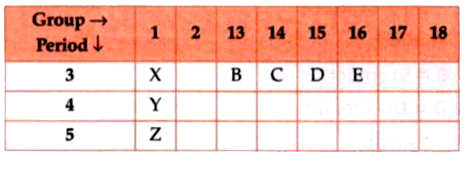An element X belongs to group 17 and third period of the periodic table
Predict its nature, whether it is metal or a non metal. Give reason.
To determine the nature of element X, which belongs to group 17 and the third period of the periodic table, we can follow these steps:
1. Identify the Group and Period:
- Element X is in group 17 and the third period of the periodic table. Group 17 is known as the halogens.
2. Determine the Element:
- The elements in group 17 are fluorine (F), chlorine (Cl), bromine (Br), iodine (I), and astatine (At). In the third period, the element is chlorine (Cl).
3. Electronic Configuration:
- The atomic number of chlorine is 17. The electronic configuration of chlorine is 2, 8, 7. This means it has 2 electrons in the first shell (K), 8 in the second shell (L), and 7 in the outermost shell (M).
4. Analyze Valence Electrons:
- Chlorine has 7 valence electrons in its outermost shell. To achieve a stable electronic configuration (octet), it needs to gain 1 more electron.
5. Determine Metal or Non-Metal:
- Metals typically have 1, 2, or 3 valence electrons and tend to lose electrons to achieve stability. Non-metals, on the other hand, have 4, 5, 6, or 7 valence electrons and tend to gain electrons.
- Since chlorine has 7 valence electrons and tends to gain 1 electron, it is classified as a non-metal.
6. Conclusion:
- Therefore, element X (chlorine) is a non-metal because it has a tendency to accept an electron to complete its octet and achieve stability.
Final Answer:
Element X is a non-metal (chlorine) because it has 7 valence electrons and tends to gain 1 electron to achieve a stable octet configuration.
---
- Element X is in group 17 and the third period of the periodic table. Group 17 is known as the halogens.
- The elements in group 17 are fluorine (F), chlorine (Cl), bromine (Br), iodine (I), and astatine (At). In the third period, the element is chlorine (Cl).
- The atomic number of chlorine is 17. The electronic configuration of chlorine is 2, 8, 7. This means it has 2 electrons in the first shell (K), 8 in the second shell (L), and 7 in the outermost shell (M).
- Chlorine has 7 valence electrons in its outermost shell. To achieve a stable electronic configuration (octet), it needs to gain 1 more electron.
- Metals typically have 1, 2, or 3 valence electrons and tend to lose electrons to achieve stability. Non-metals, on the other hand, have 4, 5, 6, or 7 valence electrons and tend to gain electrons.
- Since chlorine has 7 valence electrons and tends to gain 1 electron, it is classified as a non-metal.
- Therefore, element X (chlorine) is a non-metal because it has a tendency to accept an electron to complete its octet and achieve stability.
Element X is a non-metal (chlorine) because it has 7 valence electrons and tends to gain 1 electron to achieve a stable octet configuration.
Topper's Solved these Questions
- DIKSHA QUESTIONS BOOK - OSWAL PUBLICATIONCHAPTER - DIKSHA QUESTIONS EXERCISE - PERIODIC CLASSIFICATION OF ELEMENTS (LONG ANSWER)
30 Videos
- DIKSHA QUESTIONS BOOK - OSWAL PUBLICATIONCHAPTER - DIKSHA QUESTIONS EXERCISE - PERIODIC CLASSIFICATION OF ELEMENTS (MULTIPLE CHOICE QUESTIONS)
13 Videos
- DIKSHA QUESTIONS BOOK - OSWAL PUBLICATIONCHAPTER - DIKSHA QUESTIONS EXERCISE - PERIODIC CLASSIFICATION OF ELEMENTS (VERY SHORT ANSWER)
9 Videos
- CHEMICAL REACTIONS AND EQUATIONSBOOK - OSWAL PUBLICATIONCHAPTER - CHEMICAL REACTIONS AND EQUATIONSEXERCISE - CASE-BASED MCQs
29 Videos
- METALS AND NON - METALS BOOK - OSWAL PUBLICATIONCHAPTER - METALS AND NON - METALS EXERCISE - CASE - BASED MCQs
29 Videos
Similar Questions
Knowledge Check
An element X belongs to group 17 and 2nd period of the periodic table. Its atomic number will be
A9B14C7D15A particular element belongs to group 13 and second period of the periodic table, it is
AGas, slightly metallicBLiquid, non- metallicCSolid, non-metallicDSolid, less metallicAn element belongs to group 15 and third period of the periodic table. Its electronic configuration will be
A1s22s22p3B1s22s22p4C1s22s22p63s23p3D1s22s22p63s23p2
An element X belongs to group 17 and third period of the periodic table
Give the formula of the compound formed when it combines with an element Y having valency three?
View SolutionAn element X belongs to group 17 and third period of the periodic table
Write electronic configuration of the element. What is its valency?
View SolutionAn element R belongs to IVA group and third period in the periodic table. Arrange the element that are palced below R and towards right in the periodic table in increasing order of atoic size and ionisation potential
View Solution
An element 'X' belongs to the third period and group 16 of the periodic table. Find out the valency of X?
View SolutionAn element X belongs to group 2 and period 3 of the periodic table. The chemical formulae of its nitrate, sulphate and phosphate respectively will be
View Solution
